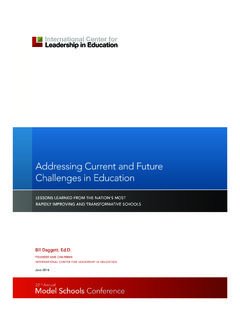Transcription of Pillars of Digital Leadership - ICLE
1 Copyright 2014 by International Center for Leadership in Education. All rights reserved. 1 Pillars of Digital Leadership Eric Sheninger As schools change, Leadership must as well. With society becoming more and more reliant on technology, it is incumbent upon leaders to harness the power of Digital technologies in order to create school cultures that are transparent, relevant, meaningful, engaging, and inspiring. In order to set the stage for increasing achievement and to establish a greater sense of community pride for the work being done in our schools, we must begin to change the way we lead. To do this, leaders must understand the origins of fear and misconceptions that often surround the use of technology, such as social media and mobile devices.
2 Effective Leadership is extremely important in any system, but it is even more imperative in schools if we are to provide all learners with a world-class education. This education has to be relevant, meaningful, and applicable. During my tenure as Principal at New Milford High School, we worked tirelessly over the course of four years to transform the culture to one that was primed for student engagement, learning, and achievement. Through the lens of social media, I was exposed to a whole new world that I didn t know existed. My subsequent journey as a connected leader and learner, resulted in small, then large shifts in professional practice that eventually served as catalysts for transformative change.
3 Thus I began to construct an area of practice around Digital Leadership . So how would one define Digital Leadership ? I think it is important to first look at the concept of Leadership in general. Wikipedia defines Leadership as a process of social influence in which one person can enlist the aid and support of others in the accomplishment of a common task. Kevin Kruse defines it as a process of social influence, which maximizes the efforts of others, towards the achievement of a goal. Both of these definitions highlight the importance of social influence. This leads me to ascertain that social media can be an invaluable tool that educators can harness to move schools, learning, and the teaching profession forward.
4 In the end, Leadership is about action, not position. Social media in all of its many forms and functions, is simply a tool to engage in conversations. In a sense, it levels the playing field by providing all leaders the same sandbox to play in. The resulting conversations that take place in these social spaces has the ability to radically transform professional practice. This is the essence of my story and countless others that effectively lead in a Digital world. Leadership is no different today than it was years ago. The only difference is that style and focus need to change with the times if we are to accomplish the lofty task of preparing students for a dynamic world, that is more socially connected as a result of technology.
5 Leading in a way that supports the status quo, standardization, outdated practices, and misconceptions related to technology not only does a disservice to our students, but also renders our schools and profession as irrelevant. We can no longer accept a head in the sand mentality as technology is changing all facets of society. The only constant non-changing entity are school buildings and many of the leaders that reside within their walls. Copyright 2014 by International Center for Leadership in Education. All rights reserved. 2 Digital Leadership takes into account recent changes such as ubiquitous connectivity, open-source technology, mobile devices, and personalization.
6 It represents a dramatic shift from how schools have been run and structured for over a century. What started out as a personal use of technology has become systemic to every facet of Leadership . Digital Leadership can thus be defined as establishing direction, influencing others, and initiating sustainable change through the access of information, and establishing relationships in order to anticipate changes pivotal to school success in the future. It requires a dynamic combination of mindset, behaviors, and skills that are employed to change and/or enhance school culture through the assistance of technology.
7 The basic tenets of Leadership are still valuable and needed for our schools to succeed. These foundational elements will never change. However, the changing times, as well as society s reliance on technology, demand an evolution of Leadership practices to create schools that our learners deserve and need to succeed in today's world. It all begins with trust. Digital leaders must give up control and trust students and teachers to use real-world tools to unleash creativity and a passion for learning. The time is now, whether you are a district, building level or teacher leader, to boldly move schools forward into the Digital age.
8 Only then will we be able to create and sustain a Digital learning culture that is relevant, meaningful, applicable, and provides all students with the skills to succeed. Once the fears and misconceptions are placed on the table, leaders can begin to establish a vision for the effective use of technology to improve numerous facets of Leadership . The challenge for school leaders is why, how, and where to begin. Digital Leadership is not about flashy tools, but a strategic mindset that leverages available resources to improve what we do, while anticipating the changes needed to cultivate a school culture focused on engagement and achievement. It is a transformed construct of Leadership that grows out of the leader s symbiotic relationship with technology.
9 The end result will be sustainable change in programs, instruction, behaviors, and Leadership practices, with technology as a pivotal element. Digital Leadership requires a shift in Leadership style from one of mandates, directives, and buy-in, to one grounded in empowerment, support, and embracement as keys to sustainable change. From my work, I have identified what I call the Pillars of Digital Leadership . These are the specific areas embedded in the culture of all schools that can be improved or enhanced through the use of available technology, especially social media. They present a framework from which any educator or leader can begin to harness the power of technology to change professional practice, and initiate sustainable change.
10 7 Pillars of Digital Leadership in Education 1. Communication Leaders can now provide stakeholders with relevant information in real time through a variety of devices. No longer do static, one-way methods such as newsletters and websites suffice. Important information can be communicated through various free social media tools and simple implementation strategies in order to meet stakeholders in the Digital age. Digital Leadership is about engaging all stakeholders in two-way communication. Copyright 2014 by International Center for Leadership in Education. All rights reserved. 3 2. Public Relations If we don t tell our story, someone else will, and more often than not, another s version will not be the one we want told.











